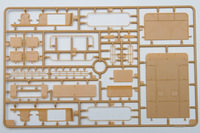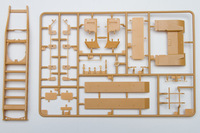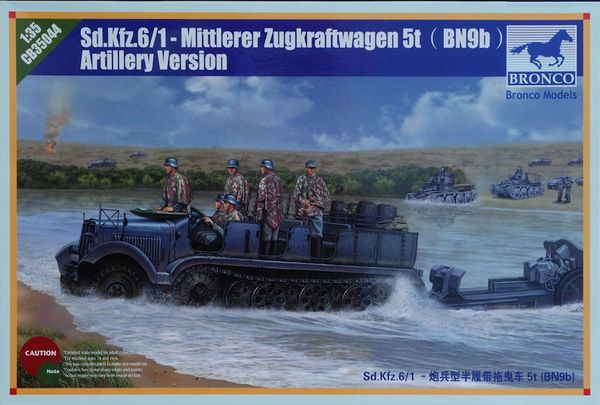
Bronco 1/35 Sd.Kfz. 6/1 5-ton Halftrack (Artillery Version)
By Eric Christianson
History
In the 1930s several types of half-track prime movers were designed and built for the German Army, generally similar in layout they differed only in size and capacity. The Sd.Kfz. 6 was one of medium size with a 5 ton (tractive force), designed by Bussing-NAG and Mercedes Benz. It was a tractor for medium-size artillery pieces such as the 10.54cm howitzer or 8.8cm Flak gun. The body had three rows of bench seats (including the cab), seating up to 10 soldiers, and a cargo compartment at the rear. It weighed 9 tons and had a speed of 50km/h and a range of 300km. Power was provided by a 115bhp 6-cylinder Maybach NL54 engine. However the Sd.Kfz was costly to produce and it was superseded by the cheaper and more effective Sd.Kfz 11 and sWS halftracks from 1941, with all production ending in early 1943. Total production of the Sd.Kfz 6 was just 3,660 vehicles. (History from kit instructions, written by Phil Greenwood)
The Kit
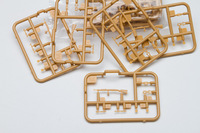
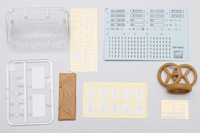 The Sd.Kfz 6/1 comes in a large, somewhat fragile box that, despite its size, is still barely able to hold the sprues and what-have-you hidden inside. On top of the pile you will find a large color poster of the same artwork that is on the box top. Next is a beautiful 20-page color booklet of instructions. An additional four-page document contains instruction updates for various changes and fixes made to the original 6/1 kit*. Under the instructions and addendum are twenty-eight sprues, plus a string for the hook and wench, backpacks, a tent roll, and optional plastic 'canvas' tops for both the cab and truck bed. Additionally, a beautiful sheet of decals and three small sheets of PE round out the contents. The main chassis comes as one piece. The decal sheet comes with some 'hard-coded' options for license plates and unit numbers, as well as generic content to let you make your own.
The Sd.Kfz 6/1 comes in a large, somewhat fragile box that, despite its size, is still barely able to hold the sprues and what-have-you hidden inside. On top of the pile you will find a large color poster of the same artwork that is on the box top. Next is a beautiful 20-page color booklet of instructions. An additional four-page document contains instruction updates for various changes and fixes made to the original 6/1 kit*. Under the instructions and addendum are twenty-eight sprues, plus a string for the hook and wench, backpacks, a tent roll, and optional plastic 'canvas' tops for both the cab and truck bed. Additionally, a beautiful sheet of decals and three small sheets of PE round out the contents. The main chassis comes as one piece. The decal sheet comes with some 'hard-coded' options for license plates and unit numbers, as well as generic content to let you make your own.
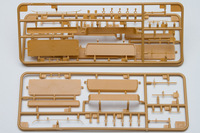
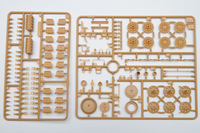 * The addendum to the instructions are coded with primary and secondary step numbers from the original instructions. Still, with half of the information in Chinese it is not easy trying to follow each change. Most of the changes involve different sprue callouts meaning that this kit has some new tooling that addresses flaws found in earlier versions. The ratio for used vs. unused parts in the kit looks to be about 70/30%.
* The addendum to the instructions are coded with primary and secondary step numbers from the original instructions. Still, with half of the information in Chinese it is not easy trying to follow each change. Most of the changes involve different sprue callouts meaning that this kit has some new tooling that addresses flaws found in earlier versions. The ratio for used vs. unused parts in the kit looks to be about 70/30%.
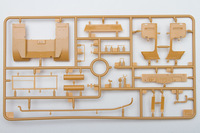
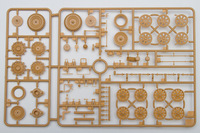 The plastic is Bronco's standard soft, light, tannish-yellow. The two front wheels are made of plastic, with an optional set that comes with separate tires and wheels.. There are 20 jerry cans taking up an entire sprue of fifty parts. Ten rifles, fifteen backpacks and a tent roll are well sculpted and will look great stashed along with the other paraphernalia on the back of the halftrack.
The plastic is Bronco's standard soft, light, tannish-yellow. The two front wheels are made of plastic, with an optional set that comes with separate tires and wheels.. There are 20 jerry cans taking up an entire sprue of fifty parts. Ten rifles, fifteen backpacks and a tent roll are well sculpted and will look great stashed along with the other paraphernalia on the back of the halftrack.
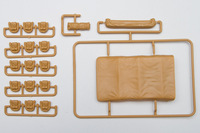
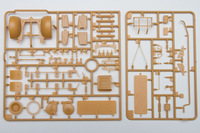 The documentation is beautifully illustrated and comes with eight three-view color drawings showing camouflage, decal placement and unit designation suggestions. Curiously, a chart containing paint callouts for Mr. Color, Hobby Color, Humbrol and Tamiya are provided, but the literal English translations ("Wood brown", "Steel") are used throughout the instructions.
The documentation is beautifully illustrated and comes with eight three-view color drawings showing camouflage, decal placement and unit designation suggestions. Curiously, a chart containing paint callouts for Mr. Color, Hobby Color, Humbrol and Tamiya are provided, but the literal English translations ("Wood brown", "Steel") are used throughout the instructions.
Construction
I have to say, if a modeler decided to close the engine compartment and not let anyone pick the model up and look at its underside (think diorama here), he or she could leave, oh, let's say, 50% of the parts in the box. That said; however, let's look at what's inside.
Transmission, Drive Train, engine and Running Gear
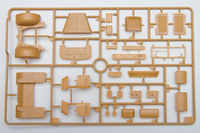 The first seven steps of the instructions, as well as three steps in the addendum deal with the underside of the half-track. Most of this is what you would expect – a whole lot of pipes and wheels and fiddly bits. There is a rather involved circular winch assembly that will have you wrap a piece of string (provided) around and around and up front to connect to a large towing hook. The new parts and instructions replace a rather finicky modification to the exhaust pipe in the original kit, and add an exhaust manifold. There are also new parts for the main (track) drive sprockets.The largest of the new parts are the side doors and front fenders and superstructure that surround the hood. The new tooling looks to have the same dimensions, but contains significantly more detail.
The first seven steps of the instructions, as well as three steps in the addendum deal with the underside of the half-track. Most of this is what you would expect – a whole lot of pipes and wheels and fiddly bits. There is a rather involved circular winch assembly that will have you wrap a piece of string (provided) around and around and up front to connect to a large towing hook. The new parts and instructions replace a rather finicky modification to the exhaust pipe in the original kit, and add an exhaust manifold. There are also new parts for the main (track) drive sprockets.The largest of the new parts are the side doors and front fenders and superstructure that surround the hood. The new tooling looks to have the same dimensions, but contains significantly more detail.
Cab and Main Roof
The dash board in the cab is all new, with raised detail for the switches and dials and generally more detail throughout. You are given several options for the roof and rear of the cab, including a transparent piece that, when painted, will represent a folded canvas cover with an imbedded pane of glass for rear-viewing – nice. With all the new detail, however, it would be a shame to cover anything up with a roof. I think I will choose to use the folded canvas parts and the new clear part thereby exposing the cab and entire truck cargo area. A lot of work would have to be added to Tamiya's FAMO kit to match what you get with this kit.
Track
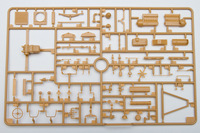 In step twelve, the track is assembled and attached. Bronco chose to use individual track link type of track. At first, the design seems daunting, but assembly is relatively simple and what you end up with is beautifully articulated, like a necklace. The hardest part is separating and cleaning the pieces, which consist of the links and a single track pad that holds each pair of links together. If Bronco could figure out a way to pre-clean these links and pads like Dragon's MagicTrack they'd make a lot of money. The instructions show 45 links per side. If that's the case, then you are provided with 22 extra links and eight special links that are not even called out in the instructions. How this all falls out will have to wait for the build article, coming soon.
In step twelve, the track is assembled and attached. Bronco chose to use individual track link type of track. At first, the design seems daunting, but assembly is relatively simple and what you end up with is beautifully articulated, like a necklace. The hardest part is separating and cleaning the pieces, which consist of the links and a single track pad that holds each pair of links together. If Bronco could figure out a way to pre-clean these links and pads like Dragon's MagicTrack they'd make a lot of money. The instructions show 45 links per side. If that's the case, then you are provided with 22 extra links and eight special links that are not even called out in the instructions. How this all falls out will have to wait for the build article, coming soon.
Seating Compartment and Rear Cargo Area
The rear seating compartment behind the cab consists of two full-width benches and a large compartmented cargo area. The cargo area contains a lot of detail that unfortunately is covered up by a single piece that fits over the top. If you want to show the smaller compartments you will need to do a little surgery to open up some spots. Still, the solid top will also act as a platform for a myriad of extra stowage that Bronco has included in the kit. This includes 20 jerry cans (10 loose and 10 in two packs of five), ten rifles with scopes, extra barrels and two clips of cartridges (each), 15 beautiful knapsacks with wrapped bedrolls, a large tent roll, and two sets of pioneer tools. Oddly, no figures are included BUT – a single German helmet - is? The rifles come with parts to stow them vertically behind each seat, five to a row.
Conclusion
Every towed artillery piece will need a prime mover, and this one's a beaut. The detail is superb and the cargo and troop carrying capacity promises an opportunity for creativity on the part of the modeler. Your finished product won't just be another stamped out copy of a half-track. The track detail (once you get it assembled!) is excellent. Even though this is an in-box review, I assembled a run of the track just to see how it went together and looked when completed. With a good finish this kit should build up into a nice and interesting representation of the real vehicle.
I recommend this kit to anyone who likes to build and finish German vehicles, and has a little experience due to the complexity of the design and the replacement sections in the documentation. That said, however, careful attention to the directions should produce a quality build.
I would like to thank Stevens International for providing this kit for review, and Internet Modeler for giving me the opportunity to review it – stay tuned for the full-build article to follow.

